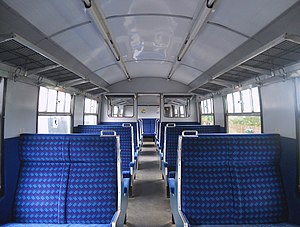This article needs additional citations for verification. (February 2010) |
| British Rail Class 421 (4CIG) | |
|---|---|
 Class 421/7 No. 1498 at North Weald in 2012 | |
 The interior of Standard Class aboard a Class 421 | |
| In service | 1964 - 2005 (Mainline services) - 2010 (Lymington branch) |
| Manufacturer | Holgate Road carriage works |
| Number built | 166 (138 class 421 (4 CIG) and 28 class 422 (4 BIG) Units) |
| Formation | Driving trailer + Motor coach + Trailer/Buffet + Driving trailer |
| Operators | |
| Specifications | |
| Train length | 265 feet 8+1⁄2 inches (80.988 m) |
| Width | 9 feet 3 inches (2.82 m) |
| Height | 12 ft 9+1⁄4 in (3.893 m) |
| Maximum speed | 90 mph (145 km/h) |
| Weight | 150 long tons (152 t; 168 short tons) |
| Traction motors | Four |
| Power output | 4 x 250 hp (190 kW) total 1,000 hp (750 kW) |
| Electric system(s) | 750 V DC third rail |
| Current collector(s) | Contact shoe |
| Coupling system | Drop-head buckeye[1] |
| Track gauge | 4 ft 8+1⁄2 in (1,435 mm) standard gauge |


The British Rail Class 421 (4CIG) electric multiple units were built at BR's Holgate Road carriage works between 1964 and 1972. Units were built in two batches, and were initially introduced on services on the Brighton Main Line. Later units were introduced on services to Portsmouth. These units replaced older Southern Railway-designed units, such as the 5Bel "Brighton Belle" units, and 4Cor units. The fleet's lifespan was 46 years.
- ^ System Data for Mechanical and Electrical Coupling of Rail Vehicles in support of GM/RT2190 (PDF). London: Rail Safety and Standards Board. 22 June 2011. p. 4. SD001. Archived from the original (PDF) on 1 April 2012. Retrieved 22 November 2022.
